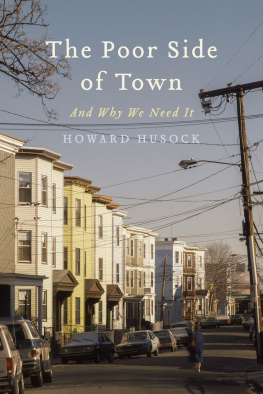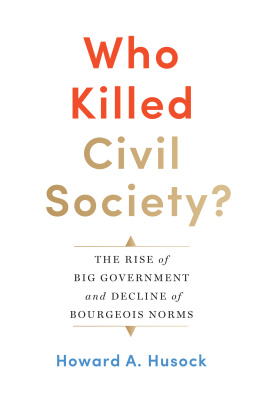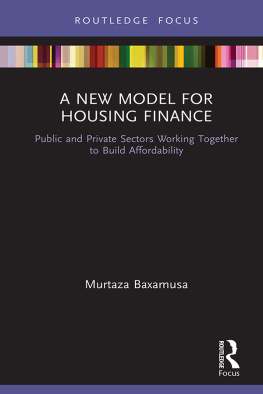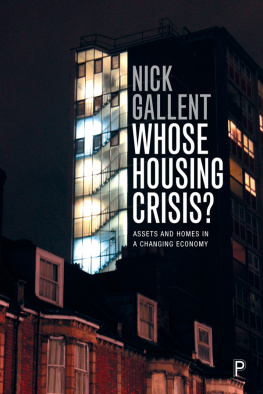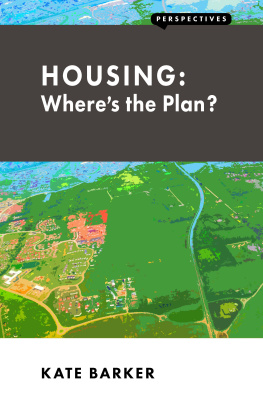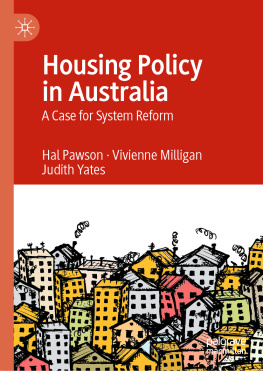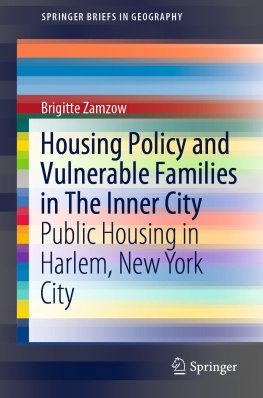The Poor Side of Town
2021 by Howard Husock
All rights reserved. No part of this publication may be reproduced, stored in a retrieval system, or transmitted, in any form or by any means, electronic, mechanical, photocopying, recording, or otherwise, without the prior written permission of Encounter Books, 900 Broadway, Suite 601, New York, New York, 10003.
First American edition published in 2021 by Encounter Books, an activity of Encounter for Culture and Education, Inc., a nonprofit, tax-exempt corporation.
Encounter Books website address: www.encounterbooks.com
Manufactured in the United States and printed on acid-free paper. The paper used in this publication meets the minimum requirements of ANSI/NISO Z39.481992 (R 1997) (Permanence of Paper).
Portions of this work have appeared in City Journal, New England Monthly, Commentary, and the Winter 2021 issue of National Affairs.
FIRST AMERICAN EDITION
LIBRARY OF CONGRESS CATALOGING-IN-PUBLICATION DATA
Names: Husock, Howard, author.
Title: The Poor Side of Town: And Why We Need It / by Howard A. Husock.
Description: New York: Encounter Books, [2021] | Includes bibliographical references and index. | Provided by publisher.
Identifiers: LCCN 2021001391 (print) | LCCN 2021001392 (ebook) ISBN 9781641772020 (hardcover; alk. paper) | ISBN 9781641772037 (ebook)
Subjects: LCSH: Low-income housingUnited StatesHistory. Public housingUnited StatesHistory. | Housing policyUnited StatesHistory. | HousingUnited StatesHistory.
Classification: LCC HD7287.96.U6 H87 2021 (print) | LCC HD7287.96.U6 (ebook) | DDC 363.5/969420973dc23
LC record available at https://lccn.loc.gov/2021001391
LC ebook record available at https://lccn.loc.gov/2021001392
Interior page design and composition by Bruce Leckie
To my wife, Robin, and family
CONTENTS
INTRODUCTION
The Neighborhoods Weve Lost and the Ones We Need
CHAPTER I
Jacob Riis and the Reformers Gaze
CHAPTER II
The Zone of Emergence
CHAPTER III
Modern Housing and the Crusade Against the Poor Side
CHAPTER IV
Yes, Yes. We Werent Dreaming: The Triumph of Levittown
CHAPTER V
The Unreformer and Her Lessons Not Learned
CHAPTER VI
The Minister and the Builder
CHAPTER VII
The Search for the Philosophers Stone
CHAPTER VIII
The Legacy of Lawrence Veiller: Zoning Out Zones of Emergence
CHAPTER IX
Maximum Feasible Opposition: The Lesson of Mario Cuomo
CHAPTER X
Slums of Hope
CHAPTER XI
Unreforming Housing
INTRODUCTION
The Neighborhoods Weve Lost and the Ones We Need
A mong the greatest experiences of my life was serving in one of Americas smallest political offices. For three terms during the 1980s, it was my honor to represent Precinct 6 at the Brookline, Massachusetts Town Meeting. In contrast to the classic New England open Town Meeting, which any adult resident may attend, ours was a representative versiona 240-member citizen legislature comprising 15 members from each of the 16 districts. All were volunteers. Yet our votes were consequential: We decided the annual budget appropriations for a municipality of nearly 60,000 people.
Debate could be intense. How much should go for the public schools, how much for the townpolice and public works and more? (We called that the town-school split.) Should the tax rate be raised? Should the long-standing ban on overnight street parking be relaxed, and should more rooming houses and bed-and-breakfasts be permitted? In a town that included both dense urban neighborhoods adjacent to Boston and postwar suburban areas, interests and issues ranged widely. Standing roll call votes could occur. There was no hiding for a Town Meeting member. During my tenure, the Town Meeting voted to phase out rent controlexposure to which helped move my own views from left to right. After I left, residents voted to permit the retail sale of marijuana. In other words, Town Meeting mattered.
As engaging and heated as such discussions could beI won one election by a single votethey were not, I now believe, the best aspect of this intense form of local democracy. What mattered more was what one would call the socioeconomic range of those gathering for several days at least twice annually in the high school auditorium to debate the warrant articles and to vote. During my time, the members included one of the most prominent geneticists in the world and the custodian at the Town Hall. There were always anti-war activists pushing for Town Meeting to pass resolutions condemning some military actionand the local American Legion leader resisting them and defending the tradition of saying the Pledge of Allegiance before sessions. White collar and blue collar, Black and white, Catholics, WASPs, and Jews, doctors and lawyers and firefighters and landscape architects.
This true diversity was not the result of some policy design. It was the natural result of the range of neighborhoods in Brookline. There was Pill Hill for the doctors, lined with historic Victorian-era mansions, and, at its bottom, the Point (formerly called Whiskey Point), historically Irish American and packed with two- and three-family frame homes. There were strongholds of New England YankeesI think of the managing partner of a downtown law firm with colonial-era roots and the long-time chair of the important Town Meeting finance committee, which hashes out the annual budget before Town Meeting votes. There were the children of the blue-collar immigrant Irish, including the head of the Public Works Department union, who would become a major regional labor leader. There were middle-class Jews whod made their way up and out of their Boston ghetto. (That would be me, if my extended family were included.) They lived in distinct neighborhoods but not at all far apart.
What was especially unusual, then, was this range of social classes working together in a shared civic polity. There were, to be sure, times when social class tensions flared, as when we debated funding for the public golf course, more likely to be used by townies than by the affluent members of private country clubs. (I didnt think we should be subsidizing golf for anyone!) But there was, without any doubt, a sense of common concern for all those who lived in the town. Among the best examples: the push to build a new school for those on the poor side of town. The drive to build the new William H. Lincoln elementary school to serve children of the Point was led by a scion of one of the oldest New England Yankee families and his wife, the head of the School Committee and an heir to a major American railroad fortune. (I was proud to serve as the Precinct 6 chair of the campaign.) Not only did the town decide to build the new school, which opened in 1994, but it hired one of Americas most prominent architects, Graham Gund, to design it.
Our diverse polity was made possible by the towns range of housing typesand, in particular, the fact that it had what one used to call, unblinkingly, a poor side of town. There were districts and pockets of three-deckers with nicknames such as the Point, the Alley, and the Village. These neighborhoods were low-income but, historically, packed with corner stores, neighborhood schools, parish churches, good hockey players (including some Olympians), and working-class homeowners who rented to extended family members and friends. They had been built in the late nineteenth century by private developers such as the Brookline Land Company, which had assessed what the laborers and maids likely to occupy its homes could afford and built accordingly. It was what I like to call naturally occurring affordable housing.

